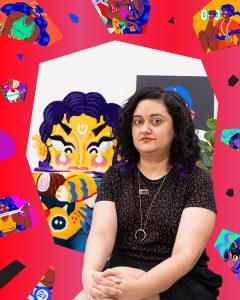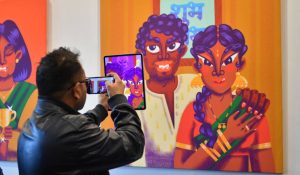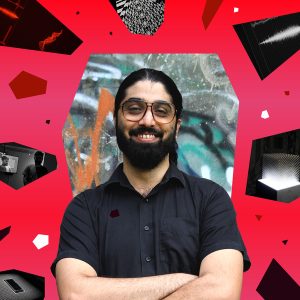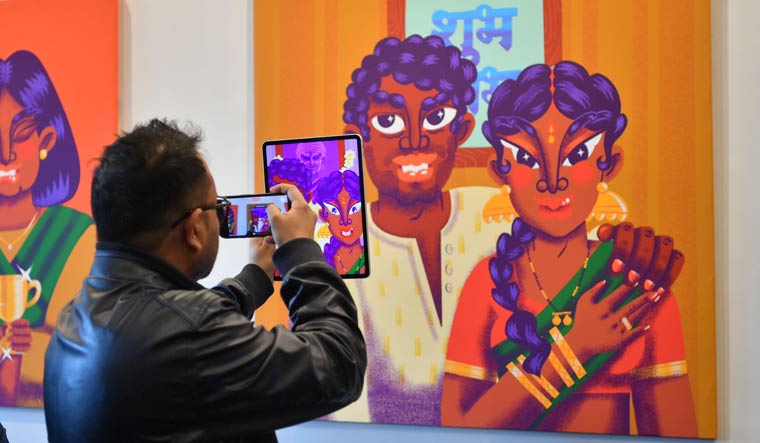Saptarshi Ghosh
From augmented reality (AR) to 3D scans of urban environments – Mira Felicia Malhotra, Gaurav Ogale and Varun Desai are three contemporary Indian artists whose practices harness latest developments in technology to critically reflect on contemporary concerns. They showed at the Digital Residency Hub at India Art Fair 2023, as part of the Digital Artist in Residence Programme. To learn more about them, read on!
Mira Felicia Malhotra

Courtesy: India Art Fair
Bold colours and pop art aesthetics conjure up the visual world of Mira Felicia Malhotra’s works. One of the most promising young artists working in the realm of digital art, Malhotra is also a graphic designer by profession, running her own design consultancy studio in Mumbai. Her works are informed by her interests in South Asian politics, feminisms, subcultures, publishing, collectives and independent music. Drawing from the kitsch aesthetics of popular visual culture, Malhotra’s vibrant visual style kicks up a riot of colours, which immediately arrests the viewer.
Witty, animated, quirky, Malhotra’s works also respond to the important socio-political issues of our times with satirical humour. Being raised in Riyadh, Saudi Arabia till the age of 11, Malhotra’s unique perspective to things is influenced by her position as someone neither an insider nor an outsider. Malhotra’s sensibilities were also shaped by her childhood fascination for TV cartoons like The Jetsons and Looney Tunes, candy wrappers and other product packaging. “I was very fond of drawing as a kid, mostly odd creatures and cartoon characters,” she says, reminiscing on her childhood. “I’d draw on myself sometimes as well, and the walls.”
View this post on Instagram
“I have little interest in realism and more for picture plane work,” she asserts. “I believe in strong concepts and content in my personal and professional work, and I have a love for single frame narratives, illustration and image-making.”
Malhotra is also invested in depicting the lives of Indian women and investigating the various issues that concern them. “I’m primarily interested in showing Indian women in ways that are typically missing in mainstream media,” she elaborates. “I want to show more women as bodybuilders, as space explorers, as angry women or even evil women — women occupying spaces in ways we don’t usually accept. I think this comes to me from my own fantasies, a desire to be able to live life in many ways.”

Courtesy: The Week Magazine
Take for instance, Malhotra’s mixed media piece Log Kya Kehenge. When the work is experienced through augmented reality, the veneer of what appears to be an ideal Indian family peels away to reveal the grotesque dysfunctional elements lying beneath. “People keep revealing to me what happens behind closed doors of Indian families and it is so different from what these families project. They want to appear very ‘normal’ but that is just a projection. It’s always about ‘log kya kahenge’. So, the AR became a perfect metaphor for that,” explains Malhotra.
At Studio Kohl, the boutique design house she runs, Malhotra has lent her unique vision to the various consultancy projects undertaken by her – from the Ramayana books by Penguin India to various digital designs for Spotify.
Gaurav Ogale

Courtesy: The Indian Express
A multidisciplinary artist based in Mumbai, Gaurav Ogale’s works are imbued with a sense of nostalgia and a desire to hold on to times long gone by. His multimedia practice comprises drawing, journaling, animating visuals, designing, poetry and other forms of storytelling. He often makes short narrative films encapsulating brief moments from his life, which unfold through doodles, paper cut-outs, typography, photographs and surreal juxtapositions.
Elaborating on his source of inspiration, he says, “I remember a lot and I hate leaving things behind. And so, I have to find a different way to carry my memories. For me, this means translating them into audio and video pieces. I create them so that I can keep revisiting my memories.”
In his works, Ogale mostly uses watercolour and incorporates digital elements. His muted aesthetics is complemented by a poetic style. The most crucial part of his process involves researching, archiving, documenting and recording. Always on the lookout for fleeting moments and stories, Ogale collects materials to add them to his collage-like visual essays and narratives – they may be sounds recorded on the streets, images saved from Instagram or lines from poems and songs.
View this post on Instagram
The decision to practise digital art came to Ogale in 2018: he was flipping through the pages of his childhood when the doodles, photos and sketches appeared trapped on the page. “I was looking at the photos and doodles and words, and couldn’t help but feel that they were trapped on page. They had to move and speak for them to be true to my memory.” The freedom offered by the digital medium to move and play around with varied audio-visual elements was alluring to Ogale.
Completing his Bachelor of Design from MIT Institute of Design, Pune in 2014, Ogale has also contributed to National Geographic Traveller India and The Wall Street Journal among other reputed publications and platforms. He has been invited to art residencies and shows at TUL in Casablanca, The Hive in Mumbai and SomoS Art House in Berlin among others.
During the pandemic, Ogale developed a new series of multimedia videos in collaboration with performing artists, exploring their individualities and intimate selves. For instance, with the renowned actor Jim Sarbh, Ogale created a visual representation of William Carlos Williams’ poem Danse Russe, a favourite of the actor. Ogale sketched outlines of Sarbh dancing to his own voiceover reciting the poem. The series was a turning point since not only did it attract attention but also introduced Ogale to the beauty of working in collaboration. “When you work with the right person, someone who understands the value of collaboration, you are able to make something truly special […],” he believes. Since then, Ogale has been working exclusively with collaborators.
Check out a similar collaboration between Ogale and Kalki Koechlin below:
View this post on Instagram
Varun Desai

Courtesy: India Art Fair
One of the most exciting multidisciplinary artists working in India currently, Varun Desai dabbles in multiple media, ranging from electronic music production to creative coding and installations. Working with the latest technologies, Desai has been pushing the frontiers of a fruitful interaction between technology and the arts. Through his works, he uncovers how enmeshed our lives are with technological influences.
View this post on Instagram
This was exactly the theme of Desai’s solo exhibition at Experimenter, Kolkata in 2021. Titled Spectre, it sought to reveal “what is necessarily not visible, but always present in contemporary life” – electromagnetic radiations and sound waves, for example. One of the works on show, Radiation, was an interactive piece, inviting the viewer to place their smartphone on a surface. This immediately triggered jarring noises, resulting from amplifying the electromagnetic waves emanating from the phone.

Courtesy: Experimenter
Working from his studio based in Kolkata, Desai uses code as a primary tool, almost akin to the paint used by a painter. “It is absolutely the same as working with paint – I go with intention, and just like painting there is a lot of room to play with chance.” Using tools like Processing on iPad, Desai deploys his technical talents to create dynamic artworks that challenge our perception of the world. Recently, Desai has also been toying with 3D scanning using the LiDAR (Light Detection and Ranging) sensor on the iPad Pro. It allows him to generate 3D scans of spaces which he then utilises in his art practice.
According to Desai, the artist’s responsibility is to recontextualise the ordinary, which allows the viewer to explore possibilities previously unknown to them. “Something might look normal, but can become extraordinary and leave a profound effect on us when observed with intent,” he posits. “It is about putting things in the right context – a tree that we pass by everyday can become extraordinary when looked at from an artist’s, designer’s or scientist’s eye.”
Bibliography
- https://www.platform-mag.com/design/mira-malhotra.html
- https://indiaartfair.in/neon-girls-mira-felicia-malhotra
- https://www.outlookindia.com/art-entertainment/doors-of-perception-mumbai-artist-uses-an-ipad-to-reveal-the-dystopic-reality-of-normal-families-at-india-art-fair-2023-weekender_story-263337
- https://indiaartfair.in/moving-memories-gaurav-ogale
- https://somos-arts.org/gaurav-ogale/
- https://experimenter.in/exhibitions/96-varun-desai-spectre-experimenter-hindustan-road/overview/
- https://indiaartfair.in/decoding-the-future-varun-desai
- https://lifestyle.livemint.com/amp/how-to-lounge/art-culture/the-future-of-tech-art-is-human-111676174914157.html#read-more





